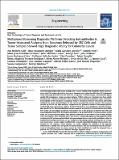Por favor, use este identificador para citar o enlazar a este item:
http://hdl.handle.net/10261/248205COMPARTIR / EXPORTAR:
 SHARE SHARE
 CORE
BASE CORE
BASE
|
|
| Visualizar otros formatos: MARC | Dublin Core | RDF | ORE | MODS | METS | DIDL | DATACITE | |

| Título: | Multiplexed biosensing diagnostic platforms detecting autoantibodies to tumor-associated antigens from exosomes released by CRC cells and tissue samples showed high diagnostic ability for colorectal cancer |
Autor: | Montero-Calle, Ana; Aranguren-Abeigon, Itziar; Garranzo Asensio, María; Povés, Carmen; Fernandez-Aceñero, M. Jesús; Martínez-Useros, Javier; Sanz, Rodrigo; Dziaková, Jana; Rodríguez-Cobos, Javier; Solís-Fernández, Guillermo; Povedano, Eloy; Gamella, María; Torrente-Rodríguez, Rebeca M.; Alonso-Navarro, Miren; Ríos, Vivian de los CSIC ORCID ; Casal, J. Ignacio CSIC ORCID ; Domínguez-Muñoz, Gemma; Guzmán-Aránguez, Ana I.; Peláez-García, Alberto; Pingarrón, José Manuel; Campuzano, Susana CSIC ORCID; Barderas, Rodrigo CSIC ORCID | Palabras clave: | Autoantibodies Diagnosis Colorectal cancer Exosomes Tumor microenviroment Humoral immune responses Point of care Biosensors |
Fecha de publicación: | 14-ago-2021 | Editor: | Elsevier | Citación: | Engineering 7: 1393-1412 (2021) | Resumen: | Colorectal cancer (CRC) is the second leading cause of cancer-related death worldwide. The 5-year survival rate of CRC patients depends on the stage at diagnosis, being higher than 80% when CRC is diagnosed in the early stages but lower than 10% when CRC is diagnosed in advanced stages. Autoantibodies against specific CRC autoantigens (tumor-associated antigens (TAAs)) in the sera of patients have been widely demonstrated to aid in early diagnosis. Thus, we herein aim to identify autoantigens target of autoantibodies specific to CRC that possess a significant ability to discriminate between CRC patients and healthy individuals by means of liquid biopsy. To that end, we examined the protein content of the exosomes released by five CRC cell lines and tissue samples from CRC patients by means of immunoprecipitation coupled with mass spectrometry analysis. A total of 103 proteins were identified as potential autoantigens specific to CRC. After bioinformatics and meta-analysis, we selected 15 proteins that are more likely to be actual CRC autoantigens in order to evaluate their role in CRC prognosis by Western blot (WB) and immunohistochemistry (IHC). We found dysregulation at the protein level for 11 of these proteins in both tissue and plasma exosome samples from patients, along with an association of nine of these proteins with CRC prognosis. After validation, all but one showed a statistically significant high diagnostic ability to distinguish CRC patients and individuals with premalignant lesions from healthy individuals, either by luminescence Halotag-based beads, or by a multiplexed biosensing platform involving the use of magnetic microcarriers as solid support modified with covalently immobilized Halotag fusion proteins constructed for CRC detection. Taken together, our results highlight the usefulness of the approach defined here to identify the TAAs specific to chronic diseases; they also demonstrate that the measurement of autoantibody levels in plasma against the TAAs identified here could be integrated into a point-of-care (POC) device for CRC detection with high diagnostic ability. | Descripción: | 20 p.-9 fig.-2 tab. | Versión del editor: | https://doi.org/10.1016/j.eng.2021.04.026 | URI: | http://hdl.handle.net/10261/248205 | DOI: | 10.1016/j.eng.2021.04.026 | ISSN: | 2095-8099 | E-ISSN: | 2096-0026 |
| Aparece en las colecciones: | (CIB) Artículos (IIBM) Artículos |
Ficheros en este ítem:
| Fichero | Descripción | Tamaño | Formato | |
|---|---|---|---|---|
| Engineering_Montero-Calle_2021.pdf | 5,15 MB | Adobe PDF |  Visualizar/Abrir |
CORE Recommender
SCOPUSTM
Citations
19
checked on 18-abr-2024
WEB OF SCIENCETM
Citations
16
checked on 19-feb-2024
Page view(s)
171
checked on 19-abr-2024
Download(s)
114
checked on 19-abr-2024
Google ScholarTM
Check
Altmetric
Altmetric
Este item está licenciado bajo una Licencia Creative Commons

